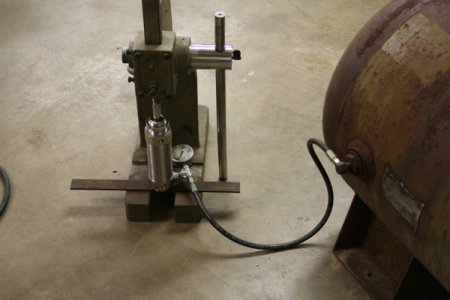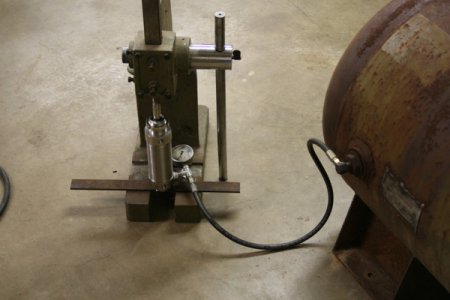- Joined
- Jan 22, 2011
- Messages
- 8,031
Ever thought about how much energy is stored in a large compressor receiver? Enough to be fatal if it were to rupture near you, and cause severe property damage in your shop. I was given a 1964 two stage compressor that has been out of service for a while, and I am working on getting it back to operating condition again. I worried about the safety of the reservoir since I had no idea how well it had been taken care of as far as keeping it drained. They tend to rust out the bottom after a few years of neglect. So......I wanted to test this tank. It had originally been certified to run at a working pressure of 200 PSI. What I did was to bring it into the shop, fill it with water and plug all the holes, save one. See the picture for what I put in that hole.

Here I have a Festo air cylinder with a tee for the gage hosed (high pressure hydraulic hose) to the tank. On the tank drain, I had a 1/2" quarter turn ball valve, and bushed it down for a male quick connect air fitting. With the system full of water, I pressured it up gradually with the shop air, and then applied pressure with the arbor press to get it up to about 300 PSI, and bounced it a few times to simulate a bit of shock loading. All I found was a 1 1/2 X 1" NPT reducer bushing in one of the holes had split from someone over-tightening it and there was a stream of water out of it. Fixed that and it's all good now. I will proceed with the blast, prime and paint, etc. It pays to be cautious and never assume something is safe when it could potentially kill you.


Here I have a Festo air cylinder with a tee for the gage hosed (high pressure hydraulic hose) to the tank. On the tank drain, I had a 1/2" quarter turn ball valve, and bushed it down for a male quick connect air fitting. With the system full of water, I pressured it up gradually with the shop air, and then applied pressure with the arbor press to get it up to about 300 PSI, and bounced it a few times to simulate a bit of shock loading. All I found was a 1 1/2 X 1" NPT reducer bushing in one of the holes had split from someone over-tightening it and there was a stream of water out of it. Fixed that and it's all good now. I will proceed with the blast, prime and paint, etc. It pays to be cautious and never assume something is safe when it could potentially kill you.


